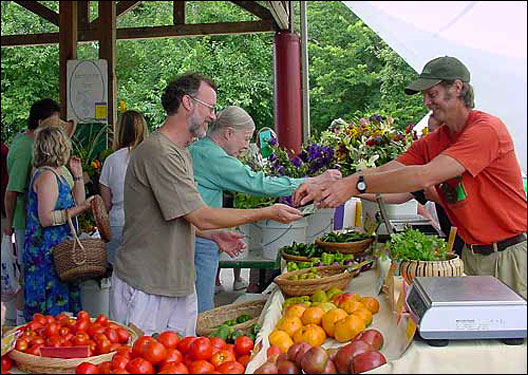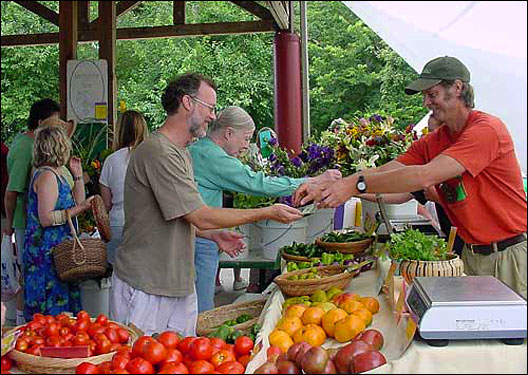
“Thank God, she’s not another one of those community activists.”
I was at Terre Madre, Slow Food’s biennial international meeting of farmers, food producers, academics, cooks, and youth delegates in Turin, Italy. I had just introduced myself to a couple of meat farmers from Oregon at the communal dinner table at our hotel. I was at Terra Madre as a food producer — a jam and pickle maker from North Carolina.
Actually, I am an activist, but in the same way that I’m a feminist: I don’t feel the need to announce it. I bristled at the comment but played it cool and went in for more information. I asked them how their day was, how they had been spending their time: conference chatter. To my surprise, after a fair amount of grumbling about long-winded talks, they confessed to being excited to hear “Will” speak.
I couldn’t resist. “Will Allen, the poverty and racism-fighting community activist?” I asked. Allen runs Growing Power, an urban-farming project based in Milwaukee and Chicago; he recently won a MaCarthur genius award for his work. He had addressed the U.S. chapter of Slow Food that day. “Ah, good one,” they relented. “But he is a farmer first.” They went on to explain that they just don’t want to be told how they were doing their job wrong by some twenty-year-old with clean fingernails.
It is easy to dismiss their reactions as simply ornery, but I suspected something deeper. There is no more radical profession in America than that of the small farmer. They are not the natural enemies of activists, are they?
After this experience at Terre Madre, I realized that I live in one of those rare places where farmers and activist don’t butt heads. Instead they enrich each other’s lives and causes. What’s the difference here in the North Carolina Triangle area?
Education of a Cook
My circuitous journey to creating a local farm-driven food business illustrates the special food culture here. As a farmer’s daughter, sister, and granddaughter, some 700-plus miles from the family farm in Mississippi, I was a geology graduate student struggling to establish North Carolina as my home. I decided that, for me, making a home somewhere meant cultivating a connection to this land as well as establishing a multi-generational community.
My first friends outside of graduate school I met through events at a local radical bookstore. Many of these educated folks were working blue-collar jobs as mechanics, carpenters, and farmers; others were librarians, journalists, and public-health professionals. There was a lot of respect for farmers in this community and recognition that feeding ourselves and others in a sustainable way was the most valuable skill that we could ever learn. An older generation of farmers provided tireless mentorship, even though it meant teaching their secrets of success to likely future competitors.
Along with farming jobs and internships, our community also has a more formal means to educate the next generation of farmers: the local community college offers extremely affordable sustainable-agriculture classes, taught by well-respected farmers, and even a two-year farming degree. Not all of those who work on farms or take these classes stick with farming, of course, but our community is stronger for it.
One of the pioneers of the Carrboro Farmers Market, retired physician Bill Dow, is responsible for fostering cross-training between cooks and farmers as well. He suggests not only that cooks come out and help at the farm, but that farmers get in the kitchen. And, most importantly, he walks the walk. I’ve seen him wait tables, wash and tear salad greens, and pick thyme. This cross-training creates greater understanding and appreciation for all of our professions and solidifies the feeling that we’re all in this together.
Farming was one of the many skills that were valued in my newfound community. Frequent skill shares fostered a do-it-yourself approach to everything from designing a website to grafting fruit trees. Coming from a hillbilly tradition of scrabbling together a living off the land however you could, these values were self-affirming.
I found myself sharing my skills of soap making and preserving. It was at one of these skill shares seven years ago that I first met Sandor Katz, who hosted a fermentation workshop. I received a Xeroxed pamphlet with a hand-drawn cover titled “Wild Fermentation” in exchange for a $2 donation. (Wild Fermentation has since been published and become a standard text for home cooks.) We made kimchi, kraut, the spongy Ethiopian flatbread injera, and tempeh. I had experimented with a few batches of kimchi before participating in Sandor’s workshop, but I left it with a newfound enthusiasm, appreciation, and awareness of a whole movement to bring live foods back into our industrial diet.
Twist and Kraut
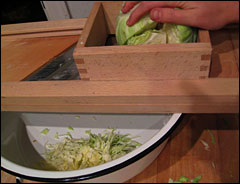
As time went on I continued to make, eat, and share a variety of fermented foods with friends. I began to see a demand for this food and began to critique our local farmers market community for not stepping up the challenge. Meanwhile, the words “value-added agriculture” had started to buzz. When the time came that I needed to break out of the restaurant scene — I was working as the pastry chef of a Chapel Hill restaurant called Lantern — I decided to try to be the change that I wanted to see. Thus, I began my journey of deciphering local and state food regulations and bringing fermented and other preserved foods to my local market. My aim was also to create a market for farmers’ surplus and slightly imperfect, though perfectly sound, local produce.
It is high cabbage season all over the country, and fall is the prime fermentation season. One of the simplest and most important fermented foods is sauerkraut. Traditional fermented sauerkraut was once such a common food in the sustenance farming families of the South that families made a 50-gallon barrel of it from the fall cabbage harvest, and it was gone before summer. The cabbage was chopped in the barrel with a sharp hoe that had been straightened out on the end and left in place, usually on the back porch, and scooped out as needed.
Kraut juice was sipped for its medicinal properties and as a bracing, delicious treat. These traditions have all but been left by the wayside. Remaining kraut consumption is almost exclusively of an industrial product, a debased adaptation lacking the nutrition, dignity, and transcendence of the authentic dish.
Real, Raw Sauerkraut
Makes 4 quarts
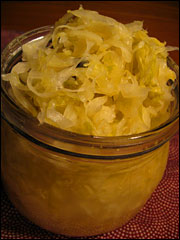
Traditional sauerkraut is long overdue a resurrection. It was a traditional and important food in the cold countries of Northern and Central Europe and Northern China (from whence it originated in prehistoric times), where it provided much needed vitamin C and probiotics through the winter, when few fresh fruits and vegetables were available. It was brought to this country by Germans — who though they did not conceive it, perhaps love it most — and other Northern and Central Europeans. To fully benefit from kraut’s nutritional properties, it should be eaten raw, uncooked, and unpasteurized. Even refrigerated versions in grocery stores generally do not qualify because they are heat-treated in order make them a stable, consistent, shippable product.
3 tablespoons sea salt or pickling salt
1 teaspoon crushed juniper berries and a couple of bay leaves (or caraway seed if you like), all optional
Remove and set aside the leathery outer cabbage leaves. Shred or chop the cabbage.
In a large mixing bowl, mix the cabbage, salt, and spices. With clean hands, squeeze or massage the cabbage to get it to release its juice. Pack the kraut in a two-gallon crock, in several gallon jars, or in a food-grade plastic container.
Fit a heavy one-gallon plastic freezer bag inside another. Fill the inner bag with a salt brine of 1 1/2 tablespoon salt to 1 quart of water and tightly close both bags to prevent leaks. Place on top of the cabbage, making sure it fits tightly around the inner edge of the crock. It acts as an airtight weight on top of the cabbage, which will discourage the growth of yeast and scum. Store the crock in a cool place (around 60-65 degrees F). Liquid will seep from the cabbage as it ferments, so place the crock on a tray or inside another container to contain any overflow.
Alternatively, you can create a seal using a plate that fits just inside your crock and is weighted down with quart jars filled with water or a large, clean rock.
Check the cabbage after 24 hours to make sure that it is completely submerged in its own brine. If not, dissolve 1 1/2 tablespoons of sea salt in 1 quart of water; pour in just enough to cover the cabbage. Let the cabbage ferment for two to four weeks, depending on the temperature of your room and how sour you like your kraut. Check the kraut every few days and remove any scum that has formed on the surface.
When the kraut is ready, it will be a light golden color and smell tart and refreshing. When soured to your liking, remove any scum from the surface and pack the kraut into sterilized quart jars. Store the jars of kraut in the refrigerator or in a very cool environment for many months.
Potato and Sauerkraut Gratin with Smoked Ham
Serves 6 as a main dish
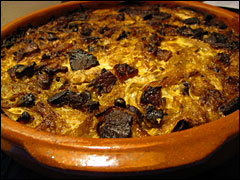
Rye bread, raw-milk cheese, kraut, and whole grain mustard sandwiches are my default lunch. However, I cannot resist the transformative nature of cooked kraut. I love it cooked simply with apples and sausages, roasted with onions and fresh pork, or used to add complexity and bite to rich and comforting cold-weather gratins, such as the one I’ve shared here. Serve with a green salad dressed with a sharp vinaigrette for a perfect autumn meal. A vegetarian version can be made without the ham; just sauté the onions in butter.
1 large onion, halved and sliced thin
4 juniper berries, crushed
1 dried bay leaf
1 1/2 pounds fresh sauerkraut, drained but not rinsed
2 pounds waxy potatoes, such red bliss, peeled, and thinly sliced into 1/8-inch-thick rounds
1 cup crème fraîche
3/4 cups heavy cream
2 tablespoons unsalted butter
3/4 teaspoon kosher salt
3/4 teaspoon black pepper
A few gratings of nutmeg
Preheat oven to 400 degrees F. Generously butter a 2-quart shallow gratin or 13 x 9 x 2-inch ceramic baking dish and set aside.
In a medium pan, sauté the ham or bacon until the ham is lightly browned or the bacon is crisp. Remove the meat from the drippings and set aside. Sauté the onion in the drippings with the juniper berries and the bay leaf until soft and golden brown. Add the sauerkraut and sauté for a few minutes to soften and to evaporate excess liquid. Stir the ham back into the sauerkraut.
Stir together the crème fraîche, the cream, salt, pepper, and a few gratings of nutmeg.
Layer 1/3 of the potatoes in the bottom of the pan. Top with 1/3 of the kraut mixture, then 1/3 of the cream mixture. Repeat two more times.
Bake in the middle of the oven for about one hour and 10 minutes, or until the potatoes are tender and the gratin is well-browned around the edges.
Let cool 20 minutes before serving.
